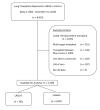An acute change in lung allocation score and survival after lung transplantation: a cohort study
- PMID: 23648947
- PMCID: PMC3819715
- DOI: 10.7326/0003-4819-158-9-201305070-00004
An acute change in lung allocation score and survival after lung transplantation: a cohort study
Abstract
Background: Lung transplantation is an effective treatment for patients with advanced lung disease. In the United States, lungs are allocated on the basis of the lung allocation score (LAS), a composite measure of transplantation urgency and utility. Clinical deteriorations result in increases to the LAS; however, whether the trajectory of the LAS has prognostic significance is uncertain.
Objective: To determine whether an acute increase in the LAS before lung transplantation is associated with reduced posttransplant survival.
Design: Retrospective cohort study of adult lung transplant recipients listed for at least 30 days between 4 May 2005 (LAS implementation) and 31 December 2010 in the United Network for Organ Sharing registry. An acute increase in the LAS was defined as an LAS change (LASΔ) greater than 5 units between the 30 days before and the time of transplantation. Multivariable Cox proportional hazard models were used to examine the relationship between an LASΔ >5 and posttransplant graft survival.
Setting: All U.S. lung transplantation centers.
Patients: 5749 lung transplant recipients.
Measurements: Survival time after lung transplantation.
Results: 702 (12.2%) patients experienced an LASΔ >5. These patients had significantly worse posttransplant survival (hazard ratio, 1.31 [95% CI, 1.11 to 1.54]; P = 0.001]) after adjustment for the LAS at transplantation (LAS-T) and other clinical covariates. The effect of an LASΔ >5 was independent of the LAS-T, underlying diagnosis, center volume, or donor characteristics.
Limitation: Analysis was based on center-reported data.
Conclusion: An acute increase in LAS before transplantation is associated with posttransplant survival after adjustment for LAS-T. Further emphasis on serial assessment of the LAS could improve the ability to offer accurate prediction of survival after transplantation.
Primary funding source: National Institutes of Health.
Figures
Comment in
-
Risk stratification of lung transplant candidates: implications for organ allocation.Ann Intern Med. 2013 May 7;158(9):699-700. doi: 10.7326/0003-4819-158-9-201305070-00011. Ann Intern Med. 2013. PMID: 23648950 No abstract available.
References
-
- Kotloff RM, Thabut G. Lung transplantation. Am J Respir Crit Care Med. 2011;184:159–71. [PMID: 21471083] - PubMed
-
- Arcasoy SM, Kotloff RM. Lung transplantation. N Engl J Med. 1999;340:1081–91. [PMID: 10194239] - PubMed
-
- Egan TM, Murray S, Bustami RT, Shearon TH, McCullough KP, Edwards LB, et al. Development of the new lung allocation system in the United States. Am J Transplant. 2006;6:1212–27. [PMID: 16613597] - PubMed
-
- Christie JD, Edwards LB, Kucheryavaya AY, Aurora P, Dobbels F, Kirk R, et al. The Registry of the International Society for Heart and Lung Transplantation: twenty-seventh official adult lung and heart-lung transplant report—2010. J Heart Lung Transplant. 2010;29:1104–18. [PMID: 20870165] - PubMed
Publication types
MeSH terms
Grants and funding
LinkOut - more resources
Full Text Sources
Other Literature Sources
Medical


